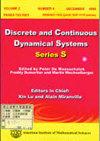粘性Burgers方程不稳定性分析的两种方法
IF 1
4区 数学
Q2 MATHEMATICS, APPLIED
引用次数: 0
摘要
当控制线性项的参数$ \ λ $超过1时,具有Dirichlet边界条件的1D Burger方程显示了从平凡稳态到正弦模式稳态的第一次过渡。本文的主要目的是提出两种不同的方法,关于这种模式稳态的转变。我们相信,这些方法可以扩展到研究更有趣的模型的动力学。作为第一种方法,我们考虑支持正弦解的方程上的外部强迫作为稳定的稳态,在临界阈值处失去稳定性。我们用连分式的方法严格地分析了相关的线性问题。特别地,我们发现系统表现出混合型过渡,在初始条件下具有两个不同的盆地,其中一个导致局部稳定状态,另一个离开原点的小邻域。作为第二种方法,我们考虑了非强制系统前两种模态的中心不稳定流形上的动力学。在这种方法中,二次跃迁产生稳态解的两个分支。在其中一个分支上有另一个跃迁,这表明存在对称性破缺现象。本文章由计算机程序翻译,如有差异,请以英文原文为准。
Two approaches to instability analysis of the viscous Burgers' equation
The 1D Burger's equation with Dirichlet boundary conditions exhibits a first transition from the trivial steady state to a sinusoidal patterned steady state as the parameter $ \lambda $ which controls the linear term exceeds 1. The main goal of this paper is to present two different approaches regarding the transition of this patterned steady state. We believe that these approaches can be extended to study the dynamics of more interesting models. As a first approach, we consider an external forcing on the equation which supports a sinusoidal solution as a stable steady state which loses its stability at a critical threshold. We use the method of continued fractions to rigorously analyze the associated linear problem. In particular, we find that the system exhibits a mixed type transition with two distinct basins for initial conditions one of which leads to a local steady state and the other leaves a small neighborhood of the origin. As a second approach, we consider the dynamics on the center-unstable manifold of the first two modes of the unforced system. In this approach, the secondary transition produces two branches of steady state solutions. On one of these branches there is another transition which indicates a symmetry breaking phenomena.
求助全文
通过发布文献求助,成功后即可免费获取论文全文。
去求助
来源期刊

Discrete and Continuous Dynamical Systems-Series S
MATHEMATICS, APPLIED-
CiteScore
3.70
自引率
5.60%
发文量
177
期刊介绍:
Series S of Discrete and Continuous Dynamical Systems only publishes theme issues. Each issue is devoted to a specific area of the mathematical, physical and engineering sciences. This area will define a research frontier that is advancing rapidly, often bridging mathematics and sciences. DCDS-S is essential reading for mathematicians, physicists, engineers and other physical scientists. The journal is published bimonthly.
 求助内容:
求助内容: 应助结果提醒方式:
应助结果提醒方式:


